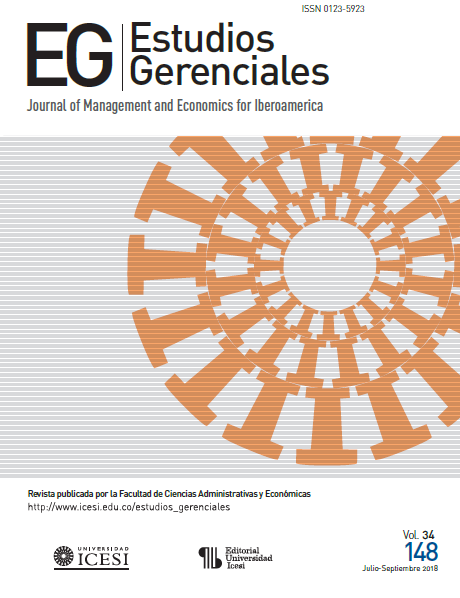Associated factors with costs behavior in periods of prosperity and economic crisis in companies of the countries that make up PIIGS
DOI:
https://doi.org/10.18046/j.estger.2018.148.2603Keywords:
costs behavior, economic prosperity, economic crisis, associated factors, PIIGS countriesAbstract
The aim of this study is to investigate factors associated with the behavior of costs in periods of prosperity and economic crisis in 473 companies in PIIGS countries. A descriptive research was conducted with documentary analysis and a quantitative approach between 1998 and 2015. The results show that organizations operate with lower profit margins in crisis times, suggesting that they adjust their cost structures to resist of these. In addition, the sales/general/administrative costs (expenses) show less asymmetry in the recession while free cash flow and fixed asset intensity increase the asymmetry. This research provides new insights for managers to identify possible avenues for decision making assertiveness, to maintain the organizations persistence in the market.
Downloads
References
Abu-Serdaneh, J. (2014). The asymmetrical behavior of cost: evidence from Jordan. International Business Research, 7(8), 113-122.
Anderson, M. C., Banker, R. D. e Janakiraman, S. N. (2003). Are selling, general, and administrative costs “sticky”? Journal of Accounting Research, 41(1), 47-63.
Balakrishnan, R., Labro, E. e Soderstrom, N. S. (2014). Cost structure and sticky costs. Journal of management accounting research, 26(2), 91-116.
Bali, S. e Demìr, E. (2015). Impact of the global financial crisis on BRICS and PIIGS countries. Eurasian Academy of Sciences Social Sciences Journal, 2(2), 90-98.
Banker, R. D., Byzalov, D. e Chen, L. T. (2013a). Employment protection legislation, adjustment costs and cross-country differences in cost behavior. Journal of Accounting and Economics, 55(1), 111-127.
Banker, R. D., Fang, S. e Mehta, M. (2013b). Cost behavior during the world crisis. Working Paper. Fox School of Business - Temple University, Philadelphia, Estados Unidos.
Buckley, P. J. e Casson, M. C. (1998). Models of the multinational enterprise. Journal of International Business Studies, 29(1), 21-44.
Calleja, K., Steliaros, M. e Thomas, D. C. (2006). A note on cost stickiness: some international comparisons. Management Accounting Research, 17(2), 127-140.
Canale, R. R. (2015). Capital flows, long term bond yields and fiscal stance: the Eurozone policy trilemma. Portuguese Economic Journal, 14(1-3), 31-44.
Caporale, G. M., Spagnolo, F. e Spagnolo, N. (2016). Macro news and stock returns in the Euro area: a VAR-GARCH-in-mean analysis. International Review of Financial Analysis, 45, 180-188.
Chen, C. X., Lu, H. e Sougiannis, T. (2008). Managerial empire building, corporate governance, and the asymmetrical behavior of selling, general, and administrative costs. AAA Financial Accounting and Reporting Section (FARS) Paper, (CAAA) 2008 Annual Conference Paper, University of Toronto and University of Illinois at Urbana-Champaign, Estados Unidos.
Chen, C. X., Lu, H. e Sougiannis, T. (2012). The agency problem, corporate governance, and the asymmetrical behavior of selling, general, and administrative costs. Contemporary Accounting Research, 29(1), 252-282.
Dalla Via, N. e Perego, P. (2014). Sticky cost behaviour: evidence from small and medium sized companies. Accounting & Finance, 54(3), 753-778.
Ely, K. (1991). Interindustry differences in the relation between compensation and firm performance variables. Journal of Accounting Research, 29(1), 37-58.
He, D. S., Teruya, J. e Shimizu, T. (2010). Sticky selling, general, and administrative cost behavior and its changes in japan. Global Journal of Business Research, 4(4), 1-10.
Ibrahim, A. E. A. (2015). Economic growth and cost stickiness: evidence from Egypt. Journal of Financial Reporting and Accounting, 13(1), 119-140.
Kokotović, F. (2016). An empirical study of factors influencing total unemployment rate in comparison to youth unemployment rate in selected EU member-states. Theoretical and Applied Economics, 23(3), 79-92.
Kumar, D. e Maheswaran, S. (2015). Return and volatility spillover among the PIIGS economies and India. American Journal of Finance and Accounting, 4(1), 28-49.
Medeiros, O. R. D., Costa, P. D. S. e Silva, C. A. T. (2005). Testes empíricos sobre o comportamento assimétrico dos custos nas empresas brasileiras. Revista Contabilidade & Finanças, 16(38), 47-56.
Noreen, E. e Soderstrom, N. (1997). The accuracy of proportional cost models: evidence from hospital service departments. Review of Accounting Studies, 2(1), 89-114.
Pamplona, E., Fiirst, C., Silva, T. B. de J. e Zonatto, V. C. da S. (2016). Sticky costs in cost behavior of the largest companies in Brazil, Chile and Mexico. Contaduría y Administración, 61(4), 682-704.
Pervan, M. e Pervan, I. (2012). Analysis of sticky costs: Croatian Evidence. In Proccedings of 4th World Conference Applied Economics, Business and Development (AEBD’12), Porto, Portugal.
Richartz, F. e Borgert, A. (2014). O comportamento dos custos das empresas brasileiras listadas na BM&FBOVESPA entre 1994 e 2011 com ênfase nos sticky costs. Contaduría y administración, 59(4), 39-70.
Santos, F. M. P. dos. (2016). Efeitos da Dívida Pública no Crescimento Económico: Abordagem Através da Aplicação de Meta-Análise. (Dissertação de Mestrado) Faculdade de Economia - Universidade do Porto, Porto, Portugal.
Subramaniam, C. e Watson, M. W. (2016). Additional evidence on the sticky behavior of costs. Advances in Management Accounting, 26, 275-305.
Zarouchas, K. (2016). Empirical analysis of bank performance in PIIGS before and during Financial Crisis. Working Paper. International Hellenic University, Thermi, Grécia.
Weiss, D. (2010). Cost behavior and analysts’ earnings forecasts. The Accounting Review, 85(4), 1441-1471.
World Bank. (2017). Development Indicators. Acessado em 09 de janeiro de 2017, de: Acessado em 09 de janeiro de 2017, de: http://data.worldbank.org/indicator/FP.CPI.TOTL.ZG .
Published
Issue
Section
License
Articles are the sole responsibility of their authors, and will not compromise Icesi’s University principles or policies nor those of the Editorial Board of the journal Estudios Gerenciales. Authors authorize and accept the transfer of all rights to the journal, both for its print and electronic publication. After an article is published, it may be reproduced without previous permission of the author or the journal but the author(s), year, title, volume, number and range of pages of the publication must be mentioned. In addition, Estudios Gerenciales must be mentioned as the source (please, refrain from using Revista Estudios Gerenciales).








